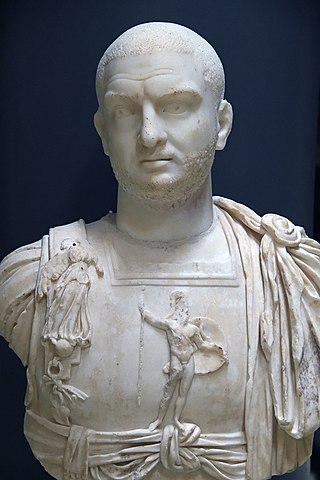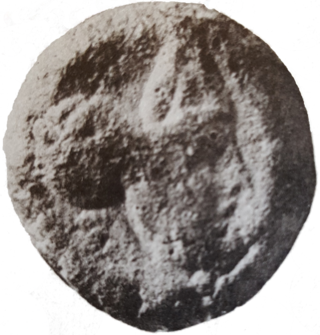
Publius Licinius Egnatius Gallienus was Roman emperor with his father Valerian from 253 to 260 and alone from 260 to 268. He ruled during the Crisis of the Third Century that nearly caused the collapse of the empire. He won numerous military victories against usurpers and Germanic tribes, but was unable to prevent the secession of important provinces. His 15-year reign was the longest in half a century.

Valens was Roman emperor from 364 to 378. Following a largely unremarkable military career, he was named co-emperor by his elder brother Valentinian I, who gave him the eastern half of the Roman Empire to rule. In 378, Valens was defeated and killed at the Battle of Adrianople against the invading Goths, which astonished contemporaries and marked the beginning of barbarian encroachment into Roman territory.
The 250s was a decade that ran from January 1, 250, to December 31, 259.
The 260s decade ran from January 1, 260, to December 31, 269.

Year 260 (CCLX) was a leap year starting on Sunday of the Julian calendar. At the time, it was known as the Year of the Consulship of Saecularis and Donatus. The denomination 260 for this year has been used since the early medieval period, when the Anno Domini calendar era became the prevalent method in Europe for naming years.

Valerian was Roman emperor from 253 to spring 260 AD. Valerian is known as the first Roman emperor to have been taken captive in battle, captured by the Persian emperor Shapur I after the Battle of Edessa, causing shock and instability throughout the Roman Empire. The unprecedented event and the unknown fate of the captured emperor generated a variety of different reactions and "new narratives about the Roman Empire in diverse contexts".

Galerius Valerius Maximianus was Roman emperor from 305 to 311. During his reign he campaigned, aided by Diocletian, against the Sasanian Empire, sacking their capital Ctesiphon in 299. He also campaigned across the Danube against the Carpi, defeating them in 297 and 300. Although he was a staunch opponent of Christianity, Galerius ended the Diocletianic Persecution when he issued the Edict of Toleration in Serdica (Sofia) in 311.

Shapur I was the second Sasanian King of Kings of Iran. The precise dating of his reign is disputed, but it is generally agreed that he ruled from 240 to 270, with his father Ardashir I as co-regent until the death of the latter in 242. During his co-regency, he helped his father with the conquest and destruction of the city of Hatra, whose fall was facilitated, according to Islamic tradition, by the actions of his future wife al-Nadirah. Shapur also consolidated and expanded the empire of Ardashir I, waged war against the Roman Empire, and seized its cities of Nisibis and Carrhae while he was advancing as far as Roman Syria. Although he was defeated at the Battle of Resaena in 243 by Roman emperor Gordian III, he was the following year able to win the Battle of Misiche and force the new Roman emperor Philip the Arab to sign a favorable peace treaty that was regarded by the Romans as "a most shameful treaty".

Gaius Vibius Trebonianus Gallus was Roman emperor from June 251 to August 253, in a joint rule with his son Volusianus.

Marcus Aemilius Aemilianus, also known as Aemilian, was Roman emperor for three months in 253.

Fulvius Macrianus, also called Macrianus Major, was a Roman usurper. He was one of Valerian's fiscal officers. More precisely, sources refer to him as being in charge of the whole state accounts or, in the language of a later age, as Count of the Treasury and the person in charge of markets and provisions. It seems almost certain that he was an Equestrian. The Historia Augusta claims that he was the foremost of Valerian's military commanders, but that is most likely a gross exaggeration, if not entirely fictitious. He followed Valerian during his ultimately catastrophic campaign against the Persians in 259 or 260; however, he remained at Samosata during the fatal battle of Edessa and his role in the events before and after the battle is questionable. After Valerian's capture by Sassanid Emperor Shapur I, Valerian's son Gallienus became sole emperor, but was occupied with his own problems in the West. Macrianus grabbed the opportunity. With the support of Balista, one of Valerian's military commanders, and with the influence that possession of the treasury of Valerian brought, Macrianus managed to have his two sons Macrianus Minor and Quietus elevated to the throne. He himself was not able to assume the purple because he was deformed in one of his legs.

Septimius Odaenathus was the founder king (Mlk) of the Palmyrene Kingdom who ruled from Palmyra, Syria. He elevated the status of his kingdom from a regional center subordinate to Rome into a formidable state in the Near East. Odaenathus was born into an aristocratic Palmyrene family that had received Roman citizenship in the 190s under the Severan dynasty. He was the son of Hairan, the descendant of Nasor. The circumstances surrounding his rise are ambiguous; he became the lord (ras) of the city, a position created for him, as early as the 240s and by 258, he was styled a consularis, indicating a high status in the Roman Empire.
Balista or Ballista, also known in the sources with the name of "Callistus", was one of the Thirty Tyrants of the controversial Historia Augusta, and supported the rebellion of the Macriani against Emperor Gallienus.

Valens Thessalonicus was a Roman usurper during the reign of Emperor Gallienus.

Lucius Calpurnius Piso Frugi was probably a Roman general whom the imperial pretender Macrianus Major sent to suppress the governor of Achaia, Valens Thessalonicus. His existence is attested only by the unreliable Historia Augusta, which labels Piso as one of several usurpers who plagued the reign of Emperor Gallienus. While some historians grudgingly regard Piso as a historical figure, many reported details of his life, including his usurpation, are dismissed as fabrications.
The Roman–Persian Wars, also known as the Roman–Iranian Wars, were a series of conflicts between states of the Greco-Roman world and two successive Iranian empires: the Parthian and the Sasanian. Battles between the Parthian Empire and the Roman Republic began in 54 BC; wars began under the late Republic, and continued through the Roman and Sasanian empires. A plethora of vassal kingdoms and allied nomadic nations in the form of buffer states and proxies also played a role. The wars were ended by the early Muslim conquests, which led to the fall of the Sasanian Empire and huge territorial losses for the Byzantine Empire, shortly after the end of the last war between them.

The Battle of Misiche, Mesiche (Μεσιχή), or Massice was fought between the Sasanians and the Romans in Misiche, Mesopotamia.
Successianus was a Roman soldier, general and praetorian prefect in the third century AD of whom very little is known for certain. He is said to have distinguished himself as commander of the garrison of an allied city besieged by barbarian pirates, and then made praetorian prefect by the emperor Valerian on the strength of this. As praetorian prefect appears to have done useful work in restoring Antioch, the capital of the Roman East, after the devastation which had been inflicted by Shapur, the King of the Persians, in his invasion of 252. However, he was overwhelmed by the circumstances with which he had to contend when Shapur invaded on a second occasion in 260 and seems to have shared in the defeat of Valerian at the Battle of Edessa and his subsequent captivity in Persia.

Coele Syria was a Roman province which Septimius Severus created with Syria Phoenice in 198 by dividing the province of Syria. Its metropolis was Antioch.
















